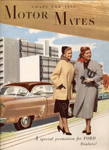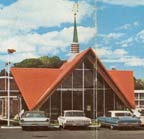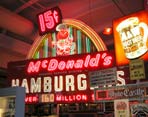
Gender and the Automobile in the United States
Gender and Automobility: Consumerism and the Great Economic Boom
Many historians consider the 1920s to be the decade that ushered in “modern times” in terms of materialism and consumerism, new cultural and moral values, rational science, and improved transportation and communications, all stimulating national standards and new rhythms of everyday life. Certainly the contrast between the New Era of the 1920s and the Progressive Reform years of the twentieth century up to 1917 was striking. And this is indeed true for the automobile and motoring in the two periods. But taking automobility to denote the availability and use of the automobile and its diffusion and importance as a social and cultural artefact, then the move from popular experience and enjoyment to mass consumption and impact did not take place until the affluence of the years after World War II enabled most groups and classes to partake in the real rather than imaginary world of easier personal road travel. Encouraged by the mass media and helped by better access to finance, many more citizens then rushed to consume goods and services. Indeed by the 1960s auto consumption had become a way of life that Americans increasingly exported to the western world and then around the globe.
The ambition to own automobiles had been established in the 1920s and was put on hold during the depressed 1930s. American involvement in World War II made travel by personal car much more difficult. The federal government rationed gasoline and tires in mid-1942 and in October of that year reduced the earlier national speed limit of 40 miles per hour to 35 miles per hour to conserve fuel and rubber. It became more difficult to drive and at times also dangerous because of the condition of frequently repaired tires and patched up essential parts of vehicles that had already been nursed through the Depression. Indeed many drivers moved back en masse onto trains and buses and travelled by public transport. Intercity travel by automobile had accounted for 89% of the total passenger miles in 1939. By 1944 car travel fell to 58.6% of the total, with public carriers now accounting for the remainder. Americans did not like the conditions on the trains and the buses, which were crowded, if not overcrowded, slow, and often broke down. Long waits in congested terminals only compounded the misery. Americans on the home front worked hard in these years of full employment, saved money because of the shortage of consumer goods, and looked forward to peace and a return to normalcy when they could buy cars and get on the road again.
The return of peace did not immediately fulfill either their aims or those of Americans who had not previously been able to afford a car. It proved time-consuming for manufacturers to switch assembly lines from military requirements to civilian automobiles, and acute shortages of basic raw materials persisted. Only in late 1946 did the government lift all priorities. Then car sales reached over 2.1 million, a figure that was slightly less than the Depression-year output of 1934. Demand was very high, but supply did not match this demand for several years even though car sales reached 5.1 million in 1949. There was a slight dip in output during the Korean War, but otherwise production continued upwards, reaching 7.9 million in 1955. By then 52.1 million cars were registered, a huge increase over the 25.8 million of the last year of the war, 1945. A decade later in 1965, car manufacturers sold 9.3 million cars and there were 75.3 million cars registered. Here was the actual spread of “autopia” or the national love affair with the car, as most Americans started to enter what Lizabeth Cohen has called “The Landscape of Mass Consumption.”
This post-war boom in automobile ownership and its ensuing automobile-based culture was not solely the result of the craving of Americans of both sexes to get behind the wheel. The federal government was anxious to ensure prosperity and security and assisted the consumer boom either directly or indirectly. The Servicemen’s Readjustment Act of 1944, more commonly known as the G.I. Bill of Rights, offered 16 million military veterans loans to buy homes or farms or to start a business. One fifth of all single-family dwellings built between the end of the war and 1966 were financed by Veterans Administration (VA) loans, and most of these houses were located in suburbia, where land was cheaper and more abundant. Automobiles then became American’s main mode of mobility. This automobile revolution was also aided by the federal government’s highway building program. The Federal Highway Act of 1944 authorized the spending of $1.5 billion in matching funds to build and improve roads. Then in 1956 the Federal Aid Highway Act authorised spending $25 billion over a twelve-year period to pay for a National System of Interstate and Defense Highways, a planned network of 41,000 miles of multilane, limited access, toll-free roads. Costs increased during the building of the interstates, but the network continued to be constructed, allowing nearly all groups to participate not only in local and regional motorization, but also in nationwide mobility. To be without a car in the United States was, except in the heart of large Eastern or Midwestern cities where a viable public transit system remained operative, to be almost in exile.
Suburbanization in single-family, low-density units, the re-domestication of women in order to care for these new homes, and differential family incomes were important ingredients in suggesting new patterns of transportation. Life in the suburbs—and by 1965 55% of those with incomes over $10,000 were suburbanites—was isolated and miserable without access to facilities. Commuting became a way of life for millions. Although these Americans were differentiated into particular communities by economic and racial discrimination, they all needed to move back and forth for work, school, shopping, running errands, and travelling to group events, whether these were religious, child-oriented, or recreational. Public transit, whether older modes like trains and streetcars or the newer bus, could not meet new individualistic aspirations and demands. The private car was the obvious practical answer, and soon there was an automobile parked on every suburban drive. Indeed, by 1960 15% of families registered ownership of two or more cars, a figure that had risen to 28% a decade later.
So where did the two sexes fit into this new level of automobility? Did they want and need the same service from automobiles, or did they have separate aims and objectives? And for those families who only owned one car, who was the prime driver and why? Work locations were slower to relocate to the suburbs than were domestic residences in the 1950s and early 1960s. Males needed to travel to work. As they were the breadwinners in most suburban families, they either drove themselves to the office or the factory or were driven to and from the local train station to continue their commute to the city. When the former happened, women often became socially isolated and frustrated, because the demand for public transit was too low to encourage private enterprise to provide service to downtown or to local retail centers. Housewives who retained control of the car during the day or those who managed to persuade their husbands that their lives would be difficult, lonely, and miserable without personal transport or that in their new upward mobility they deserved their own vehicle, whether new or second-hand, gained independence as well as mobility. For both of these female suburbanites, the car became almost a second home.
Initially such women got behind the wheel to shop. Retail outlets might be grouped a mile or more away from their homes, but these were gradually shifted into more purpose-built shopping centers. Such off-street retail complexes were frequently dedicated to domestic, if not female-oriented, consumption, and they were planned as primarily female meccas because market analysts estimated that women did between 67 and 92% of family shopping and spent considerable time at the stores. Designed to facilitate car access and to offer a variety of services in a one-stop journey, shopping centers increased from 8 in 1945 to 3,840 by 1960. Frequently anchored by department stores, they accommodated a number of different shops and services, thereby drawing in consumers from both the neighborhood and the region. If supermarkets were not located in these shopping centers, they required a separate visit from the motorized suburban housewife who wanted to take the weekly supply of food home in one journey. Indeed the supermarket came of age in the decades of post-war affluence. In 1950 it accounted for 35% of American food sales; a decade later this percentage had doubled. Not only did the low prices appeal to consumers' sense of value, but the supermarket also fitted the new automobile-led middle-class way of life. Supermarkets responded to their growing popularity by becoming bigger and better, by carrying new branded products and more sizes of pre-packaged foods, and by having larger parking lots.
Suburban women also perceived the growing need to transport children by car, initially to school. As more children’s activities became organized into such groups as Girl Scouts or Little League, in addition to the more traditional piano or dancing classes or school bands, mothers became major transporters of their offspring. While the yellow school bus might pick up children from the edge of the suburban complex, it was not privatized to adjust to the individual interests of specific families. Mothers wanted and needed to run their children from pastime to pastime. Indeed William Chafe has observed that the suburban family was essentially run by children. Even the advent of television, which by the mid-1950s was a feature of 66% of homes, did not prevent this child-centered mobility. Add to the shopping and children’s activities trips to doctors’ and dentists’ offices and visits to friends, families, or clubs, then it is easy to see that many suburban housewives were becoming dependent on the automobile to carry out domestic responsibilities and to pursue their own interests.
Suburban housewives might be synonymous with the growing numbers of white middle-class women in these decades, but other women were also interested in automobility in the post-war years. Increasing numbers of females were gainfully employed and were working wives or working mothers. By 1960 over twice as many women were employed as in 1940. The remarkable shift in this female labor force participation took place among married women with husbands present, revealing a 139% increase in women aged 35-44 and a 254% increase among the 45-54 year olds. Married women, frequently in older age groups and from the middle class, were leading the surge in the growth of employment in the service sector, where many women were already working. Whether they were suburban or metropolitan, they not only carried out their domestic responsibilities but also had to get to work. They were interested in multi-tasked journeys and faced complicated travel patterns that could not be accommodated by public transport. They, too, became gainfully employed commuters who wanted to drive themselves to work.
Yet there is more to gendering automobility in the post-war years than putting more women behind the wheel on a regular basis. Two other notable features of the mass spread of the car culture of the 1950s and 1960s were teenagers on the road and family vacations, and the overlapping dependence on roadside facilities used by both groups. In addition to the car parked on the drive as an icon of post-war society, vacation trips became another status indicator as well as being a potential time for enjoyment. Mark Foster has well described the less-than-relaxing reality of vacation trips for millions of blue-collar workers who were enjoying their first paid holidays in the late 1940s and early 1950s. Travelling in non-air-conditioned vehicles, usually with the father driving, mother navigating, and the children in the back seat, staying at motels that were still of the “mom and pop” variety and thus lacked amenities and often charged extra for children, was not a restful experience for anyone in the family. But as with many service sector businesses in the 1950s, entrepreneurs quickly seized the opportunities of a buoyant economy in which recreation and leisure were becoming important to American lives and promoted automobile-oriented businesses. Motel construction boomed in the late 1950s and the 1960s, and by 1964 there were 62,000 motels in the United States. Stimulated in part by the tax code of 1954 that allowed rapid depreciation of construction costs, some motels were flimsy, but others offered an enjoyable, secure and entertaining “home on the road.” Here family travellers re-energized in order to move on, whether their stay was in a franchised “no surprise” accommodation, an economy lodging, or a roadside inn.
In addition to lodgings, automobile tourists and travellers of both sexes needed food and gasoline service stations. As with the motel, limited-menu, fast-food chains emerged on or near major highways. Even before World War II, coffee shops, roadside stands, and new “drive-in” restaurants offered an eating experience that was integrated with automobility. As cars became much more central to post-war travel plans, families, especially working-class families, wanted quick, cheap and substantial meals at the roadside. More quick service, fast-food “eateries” emerged to meet the demands of automobile convenience. Howard Johnson’s expanded in the 1950s by merging the casual soda fountain with more formal dining into the familiar orange-roofed chain of family restaurants where children were welcome. White Castle, focusing on the hamburger served in look-alike diners, also expanded to cater to nervous mothers and families travelling without reliance on home cooking. This chain was soon overtaken by another generation of roadside eateries, McDonalds. Started in 1954, McDonalds had 82 outlets in 1966. Six years later it ranked second of all the food service operations in the United States with over 1,000 franchises. The rapid delivery of a uniform quality mix of prepared foods in a clean, orderly, and cheerful environment with drive-up or drive-in facilities underwrote the success of the “Golden Arch” operation. This “place-product-packaging” concept that co-ordinated architecture, décor, product, service, and working routine nationwide, set the standard for many imitators as they delivered uniform food products to a nation in a hurry and on wheels. And these fast-food outlets became more than the choice of tourists of both sexes in the post-war years. They attracted home-based families who wanted to give mother a rest from preparing meals, and they become the haunt of teenagers on wheels. Doubtless they, too, were hungry, but they also wanted a space in which to socialize with their peers.
Teenagers were publicly recognized as a growing phenomenon in the 1950s and 1960s. The offspring of the parents who had married young during the war or immediately thereafter, these “baby boomers” forged their own lifestyle, a proportion of which was centred on access to the car that could give them freedom. Having wheels meant escape from prying eyes, gaining “street cred[ibility]” among high-school or college peers, and access to the local automobile culture. Gaining a driver’s licence was, as Kenneth Jackson suggests, the most important rite of passage in the high-school experience. While the majority of teenagers who inherited and customized “hand-me-down jalopies” were young males, young females were by no means debarred from teenage automobility. Indeed, they were central to this style of youth culture. Part of teenage driving was to impress other male students about knowledge of and intimacy with car technology, but another part was to be seen cruising with a popular girl, often enjoying the new rock and roll music to the annoyance of the older generation. To join the scene teenagers also frequented the local drive-in restaurant or visited the drive-in movie theatres. By 1950 there were 1,700 outdoor drive-in movie theatres, a number that grew to 4,200 only four years later. Reaching their height of popularity in the late 1950s and known as “passion pits” by both their critics and admirers, they offered teenagers, more so than families, a haven where they could be themselves while watching road movies or movies with automobile themes at bargain-basement prices, if not indulging in other activities.
During the years of confidence in the twenty to twenty-five years after World War II, the automobile moved to center stage in American life. For both sexes of all ages, it became a household vehicle, if not technology that changed their way of life. It was the house on wheels. Girls and women viewed the car and its culture in differing ways from boys and men, but everyone wanted access, increasingly as drivers as well as passengers. Even though the years of liberalism in the 1960s also provided a sharp critique of the hypothetical benefits bestowed by automobility, car production and sales continued to rise as Americans became more dependent on their personal vehicles and public transit systems offered few alternatives to the increasing number of people living in suburbs. There was a growing awareness of the environmental, energy, and safety problems created by high levels of driving, but remarkably little action was taken as all Americans aged 16 and over (and sometimes younger) took to the road to pursue their individual desires and commitments.
<<Previous Section - Next Section>>
Placing Gender and Automobiles into Perspective
Gender and Automobility: The Pioneering and Early Years
Gender and Automobility: Consumerism and the Great Economic Boom
Gender and Automobility: Sexual Equality in Modern Times
For the impact of highway building on Detroit, see Thomas Sugrue’s “Building the Motor Metropolis.”
Retail outlets and Shopping Centers
About the Project | Credits | Contact Us | Student & Teacher Resources | Site Map
©2004 Automobile in American Life and Society





